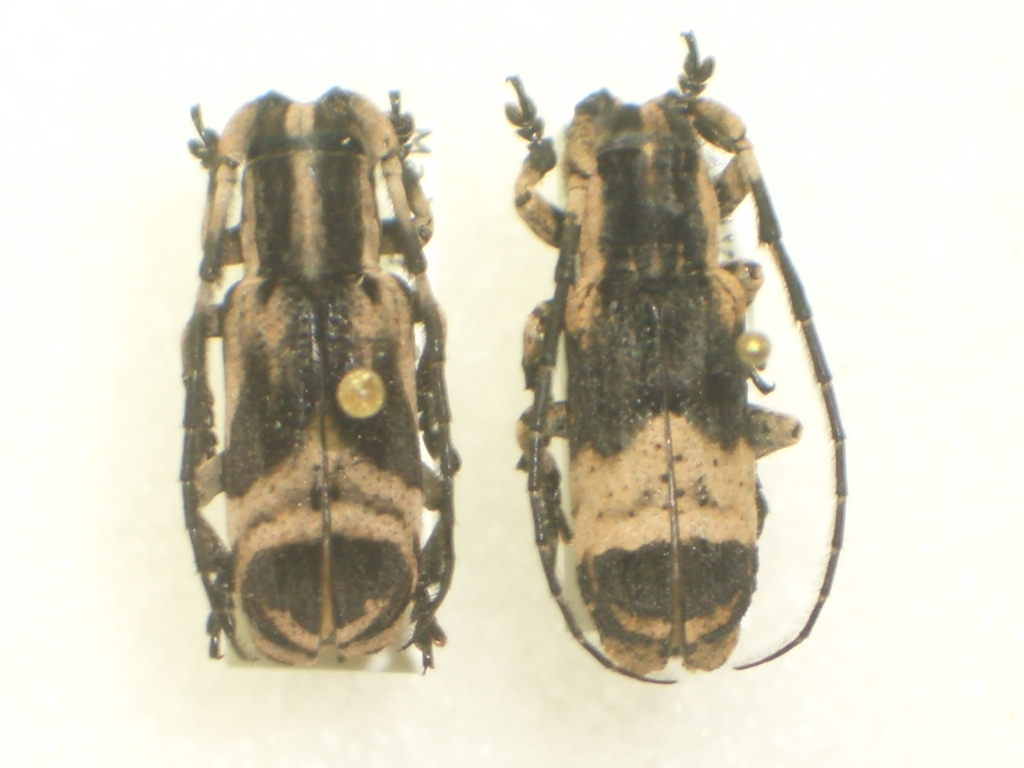| T O P I C R E V I E W |
| dryobius |
Posted - 04/12/2014 : 22:45:26

347.56áKB
This species has been illustrated before.
These two specimens are from the same area of Sabah. The form on the left is typical. The form on the right is very uncommon. |
| 10 L A T E S T R E P L I E S (Newest First) |
| Xaurus |
Posted - 09/12/2014 : 01:05:06
Yes Dan, this is quite remarkable, maybe this spms belong to S. longeantennatus Breuning, like such sps from Yunnan, I have only few material for comparision to check the variability.
|
| dryobius |
Posted - 07/12/2014 : 22:23:52
thanks Andre..
My original post would appear to be a photo of S. franciscanus and pascoei. This would be the first record for S. pascoei from Borneo that I know of. What still puzzles me is the difference in the lengths of antennae. Xavier's specimens from Laos have rather longer antennae than my specimen. Andre's 3 specimens all appear to be females with much shorter antennae. |
| Xaurus |
Posted - 07/12/2014 : 19:02:07
I have put together some pictures of Sthenias, really not easy this genus, I hope anybody can provide the HT picture of S. pascoei (should be in Leiden?).
Xavier maybe you are right our spms from S-Yunnan in the book are wrong. A nice group for revision too  ! !
You see Breuning's key is really helpfull 

386.48áKB |
| Bennyboymothman |
Posted - 07/12/2014 : 16:54:19
My data for the above specimen is
02-2012 - Tanah - Cameron Highlands - Pahang - West Malaysia |
| Xavier |
Posted - 06/12/2014 : 10:56:16
If my 2 laotian specimens are not S.pascoei, ID from Wiegel & lin and ID of picture in Gallery's forum are wrong too.
Bennyboy : tell us where your specimen comes from, please. |
| dryobius |
Posted - 05/12/2014 : 23:48:06
The type locality of S. franciscana is "Malaysia". And I don't have a photo of the holotype. I believe your specimen is S. franciscana. But where is it from?
The distibution of S. franciscana (per Hua, 2002) is from Java to China.
The photos posted by Xavier (two from Laos) are probably males (but what species?) and seem to have longer antennae than my two males from Sabah. Two females in my collection from Sabah have antennae that extend only to the apical fifth of the elytra.
|
| Bennyboymothman |
Posted - 05/12/2014 : 19:03:11
Here is one from my collection as well to add to the topic.
ps. Is mine Sthenias franciscana? With the pale stripe on the head?

331.65áKB |
| Xavier |
Posted - 05/12/2014 : 17:23:11

I add to yours 2 specimens from Laos to compare. I called them Sthenias pascoei Ritsema, 1888.
I placed here the Breuning's key of the sg Sthenias. |
| dryobius |
Posted - 05/12/2014 : 16:14:25
Yes, possibly two species, BUT ... Ritsema described (that's giving him a lot of credit for a few words) S. pascoei and stated that it was the correct name for what Pascoe had described in his Longcornia work (page 160). Yet Pascoe, didn't provide a photograph.
Pascoe's description of "grisator" which is what Ritsema said should be called "pascoei" is another one of his vague descriptions which is difficult to visualize. The only part of his description which is not ambiguous is the statement that says "third and fourth [antennal] joints ringed with greyish at the base". Note that my specimen only has the 3rd antennal joint ringed at the base. I believe there have been photos of this Sthenias posted previously which have even less black pubescence.
Pteropliini are generally cryptically colored species and have an extreme tendency for individual variation, but one must get a good series of specimens in order to see this. Further material and study is again required in order to make certain this identification. |
| Xavier |
Posted - 05/12/2014 : 09:43:50
I think you have 2 differents species, and on the right it's Sthenias pascoei Ritsema, 1888
On the left, it's possibly Sthenias franciscana Thomson, 1865, but I'm not able to recognize it. |


